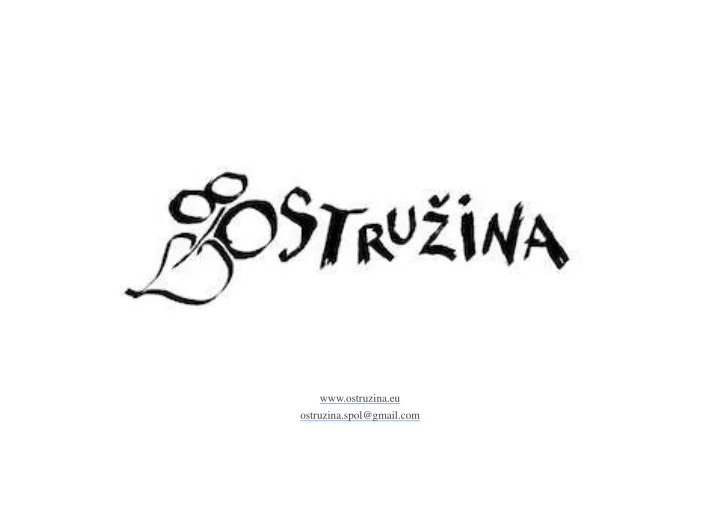

www.ostruzina.eu ostruzina.spol@gmail.com
Based in the Czech republic, OSTRU Ž INA z.s. is an artistic group led by the dancer, choreographer and pedagogue Barbora Látalová DiS. in collaboration with dance artist and researcher Mgr.art Zden Brungot Svíteková and artist and production manager Mgr. Lucie Ra č ková. We produce high-quality works in the field of professional dance for all generations, with special focus on young audiences and families. OSTRU Ž INA z.s. activities reflect current issues of quality of life, social cohesion, diversity, equality, participation, and accessibility to culture. Our drive is to create conditions where an individual and/or a community can actively and creatively develop his/her full potential as well as the relationship to society and the environment.
interPlay https://vimeo.com/312179930 https://vimeo.com/315540365 creation 2018
a creative family lab, where families meet with families designed for anyone from 6 to 120 years old + InterPlay is a getting together to interact and collaborate, with an aim to have fun and play around. You are invited to join in a game of what can and can’t be seen. Bring your children, parents, family members and relatives. Your fellow players will be your imagination and creativity, loose comfortable clothing to move around in, and Bára, Zdenka, Jan and Václav.
Creators, roles & background creators, performers: Zden Brungot Svíteková (dancer, performer, maker, teaching artist), Barbora Látalová(dancer, performer, choreographer, teaching artist), Jan Bárta (performer, theatre maker, teaching artist, DvT practitioner), Václav Kalivoda (musician, composer, performer) dramaturgy consultancy: Eva Rosemarijn (theatre maker, dramaturge, producer) Genesis of the project: the piece evolved in the lineage of following dance pieces: Animal Carnival https://zdenkabrungotsvitekova.wordpress.com/animal-carnival/ http://www.ostruzina.eu DIFFERENT? https://zdenkabrungotsvitekova.wordpress.com/di ff erent/ http://www.ostruzina.eu Focus of the project: communication and collaboration intergenerational encounter family members encountering each other in a di ff erent context and role families meeting families Structure of the work: score in 5 parts with defined time frame and tasks while the content remains open a 20’ open play is part of the score, highlighting the fact that everyone is the creator having ownership of the content
QUESTIONS: format - where on the spectrum performance - social event - workshop? finances - free or payed? | how to finance these activities? space - theatrical or non theatrical spaces? and if non theatrical which ones? context - how does it influence whether the work is received as theatre or a more therapeutic event liability if anything happens - how to be covered for the case?
one of our colleagues has training in: Developmental Transformations (DvT) TOWARDS THE BODY AS PRESENCE developed by David Read Johnson and colleagues from 1974-1992 | https://primediscrepancy.wixsite.com/dvt40/about Developmental Transformations is a form of drama psychotherapy that is based on an understanding of the process and dynamics of free play . The essence of Developmental Transformations is the transformation of embodied encounters in the playspace . four components of this approach: 1 Transformation - Instability of Being deriving from the experience of di ff erence, find stability by embracing instability 2 Embodiment - engagement of the entire sensory system 3 Encounter - learning in the proximal environment is likely to be long lasting and readily applicable. 4 Playspace - play = destination, mediation in relationship, practice of freedom Important aspects of this approach include: (1) the sessions consist entirely of dramatic, improvisational interaction between the therapist and client(s), (2) the therapist is an active participant in the play and intervenes through his/her
own immersion in the client’s playspace, (3) the process of play is used to loosen or remove (i.e., deconstruct ) psychic structures that inhibit the client(s) from accessing primary experiences of Being (i.e., Presence), and (4) the client’s progress in treatment is believed to follow natural, developmental processes that in themselves will lead to greater emotional health. Developmental Transformations (DvT) is based on the theatrical ideas of Jerzy Grotowski (Grotowski, 1968; Johnson, Forrester, Dintino, James, & Schnee, 1996) and Viola Spolin (Johnson, 1982; Spolin, 1963). numerous theoretical perspectives have been incorporated to understand the processes involved. psychological perspectives of cognitive development (Johnson, 1999; Piaget, 1951; Werner & Kaplan, 1963), psychotherapeutic perspectives of psychoanalysis , particularly free association (Freud, 1920; Kris, 1982), object relations theory (Jacobson, 1964; Klein, 1932), client-centered therapy (Rogers, 1951; Gendlin, 1978), authentic movement (Whitehouse, 1979), and dance therapy (Sandel, Chaiklin, & Lohn, 1993); philosophical perspectives of existentialism (Sartre, 1943), postmodernism (Deleuze & Guattari, 1987; Derrida, 1978), and Buddhism . feelings reflection (as part of the structure) - needed?
theatrical and performance settings - therapeutic potential what is the line between art and therapy? the responsibility of the artist? how to hold the space in fragile, heated or violent situations? examples and concrete tools or solutions for handling them important elements of the structure and in what form? (such as reflection time, verbal discussions, …) what to be aware of and what skills or training are necessary? and for which contexts? (in which contexts therapeutic e ff ects might surface?) being an artist having a therapeutic training or background in therapy How do the two practices inform each other? When the training in therapy interferes with the artistic: How to handle situations when the therapeutic training interferes with the artistic potential of the moment?
drawings by the participants
Recommend
More recommend